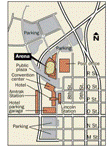Community and Regional Planning Program

Community and Regional Planning Program: Faculty Scholarly and Creative Activity
Document Type
Article
Date of this Version
2011
Citation
Published in Environmental Planning, ed. Rebecca D. Newton (New York: Nova Science, 2011).
Abstract
Drought is a normal part of the climate cycle, affecting every climate regime on the planet. Drought indicates a special period in which an unusual moisture scarcity causes a serious hydrological imbalance. Drought is related to the timing and effectiveness of the rains, high temperature, high wind, and low humidity. The typical impacts of drought may include dry lands, low or empty water-supply reservoirs, low groundwater levels (dried up wells), crop damage, and ensuing environmental degradation. In the United States, drought accounts for losses in the billions of dollars. In fact, a FEMA (1995) report estimates the average annual losses due to drought at $6-8 billion, on a par with hurricanes, making these the two most costly hazards impacting our country. Drought often affects several sectors (agriculture, recreation and tourism, energy, forestry, and others) at the same time and typically impacts large areas and many people. These impacts serve as indicators of our vulnerability and risk during extended periods of rainfall deficits.
Our vulnerability to drought is affected by (among other factors) population growth and shifts, urbanization and sprawl, demographic characteristics, technology, water use trends, government policy, social behavior, and environmental awareness. These factors are continually changing, and society's vulnerability to drought can increase or decrease in response to these changes. Although drought is a natural hazard, society can reduce its vulnerability and therefore lessen the risks associated with drought episodes. The impacts of drought, like those of other natural hazards, can be reduced through mitigation and preparedness. Planning ahead in an attempt to mitigate drought gives decision makers the chance to relieve the most suffering at the least expense. Reacting to drought in "crisis mode" decreases self-reliance and increases dependence on government and donors (Wilhite and Pulwarty, 2005).
As a proof of concept approach, this paper looks into the process of comparing and evaluating state drought plans within the United States. The idea of evaluating (scoring) drought plans may be new, but similar methods have been applied to other hazards and in other planning fields, such as the environmental and urban/rural planning sectors (Baer 1997; Berke 2000; Brody 2003; Tang et a\. 2008). Even so, the planning profession itself has developed relatively few criteria for evaluating the quality of plans, so plan quality is difficult to define (Baer 1997). Now, and in a changing climate with changing vulnerabilities, Brody (2003) aptly notes that planners must be flexible, adapting and planning for changing conditions by gearing their efforts more toward uncertainty and surprise. Thus, the purpose of this paper is to assess the potential transferability of evaluation techniques in other fields and hazards to the evaluation of drought plans in the United States.
Included in
Cultural Resource Management and Policy Analysis Commons, Urban, Community and Regional Planning Commons


Comments
Copyright (c) 2011 Nova Science Publishers, Inc. Used by permission.